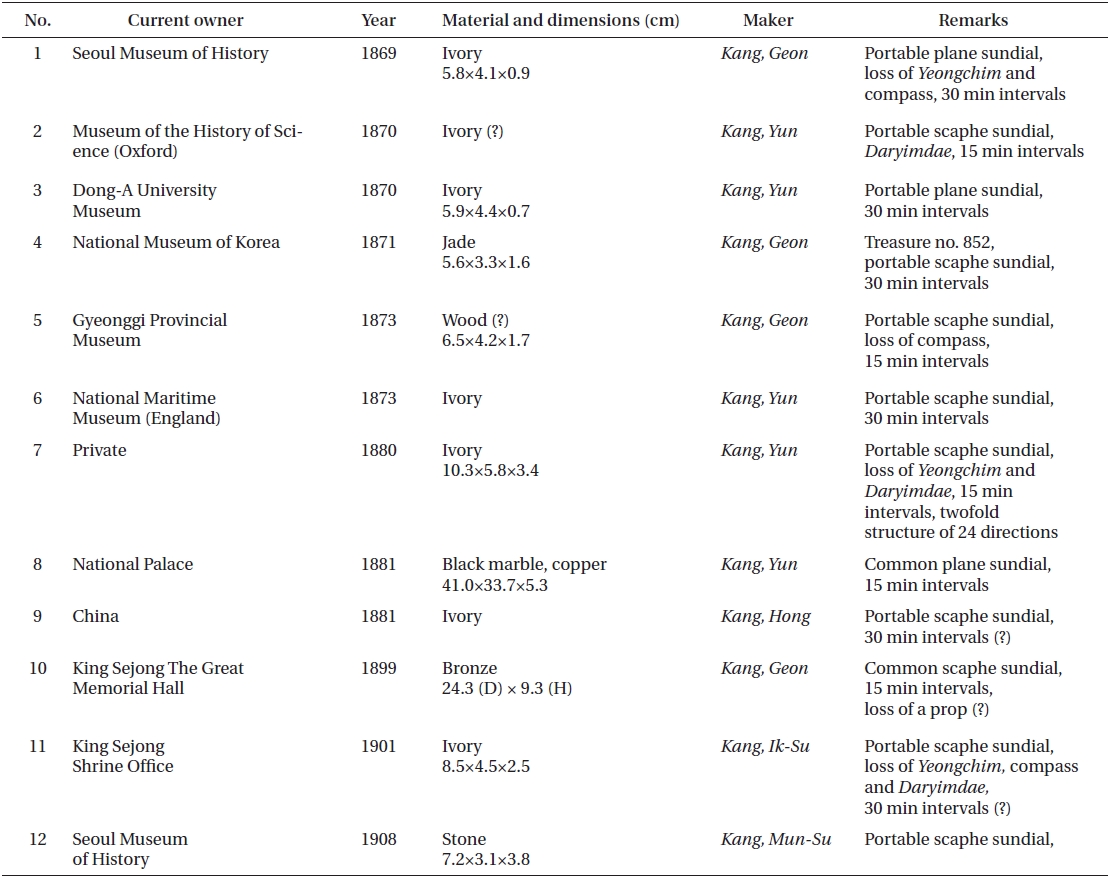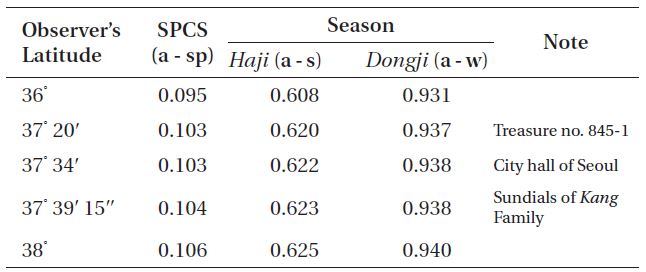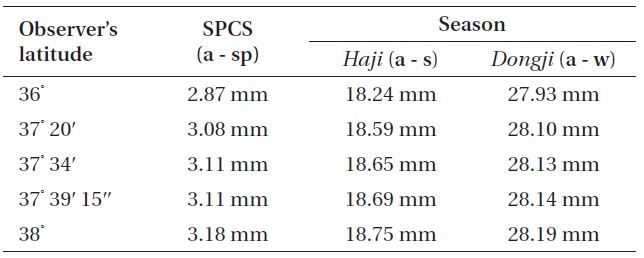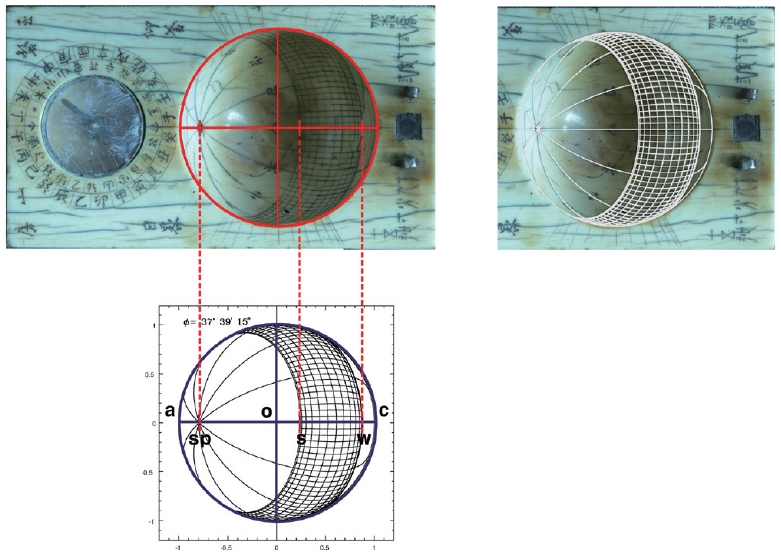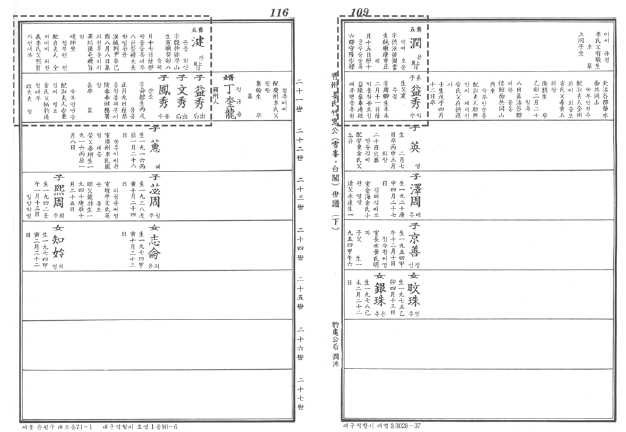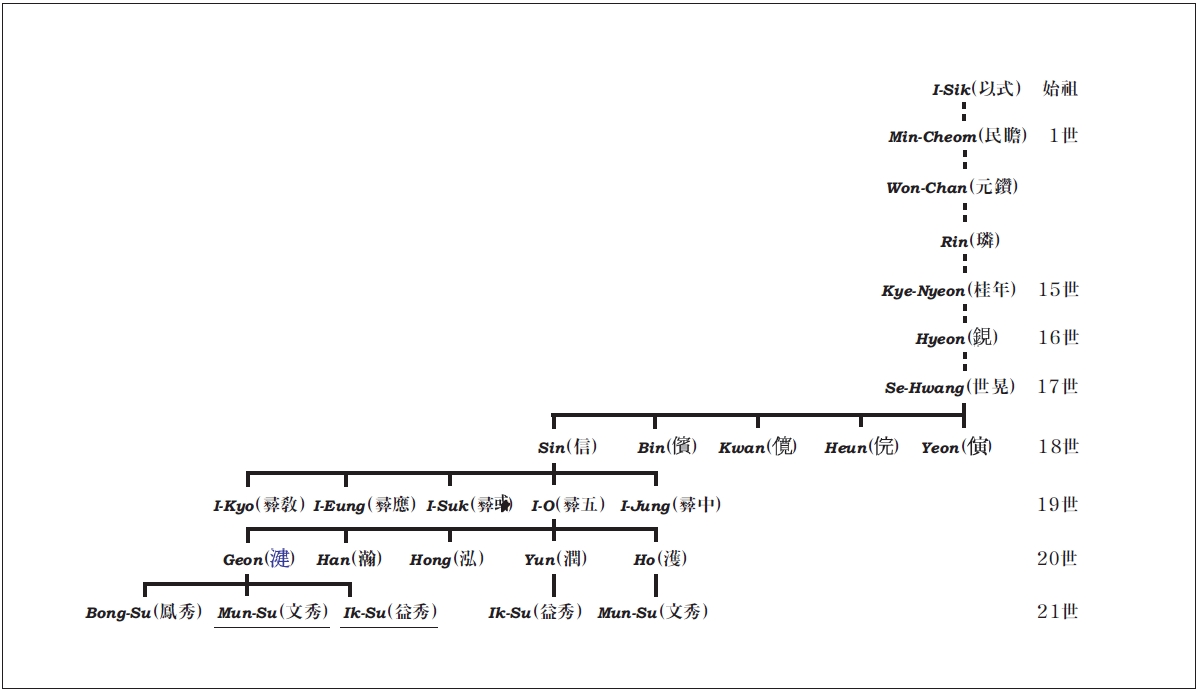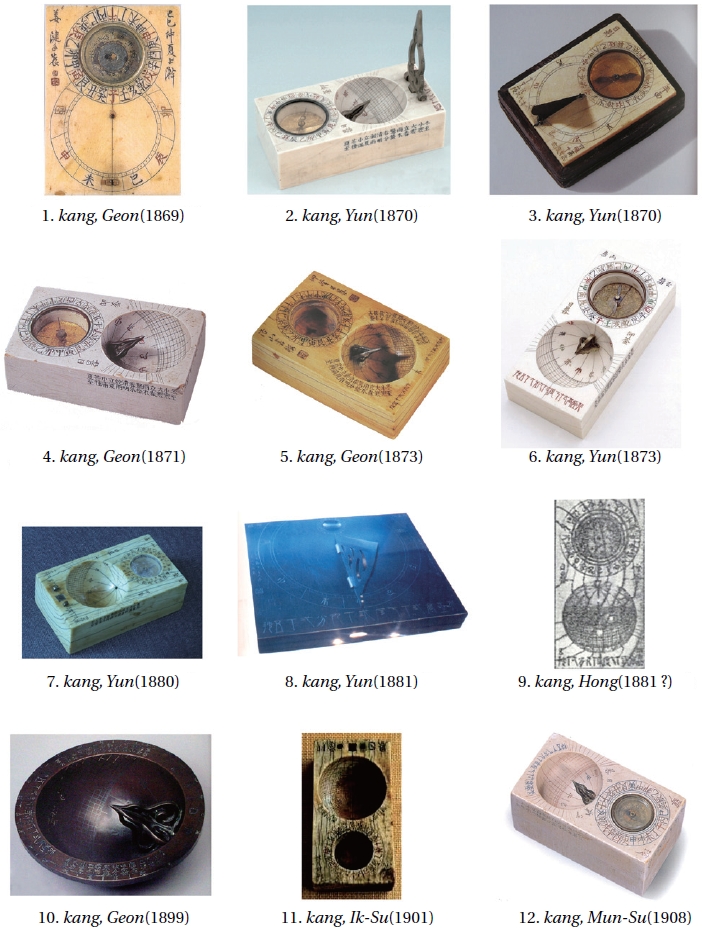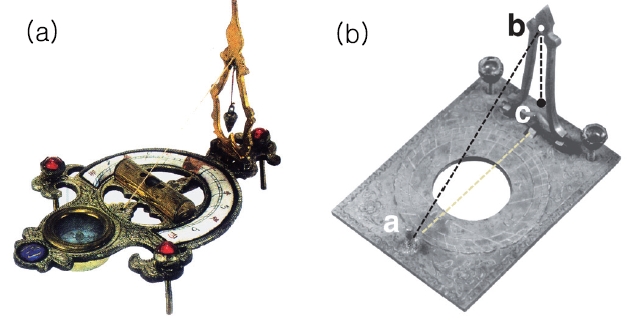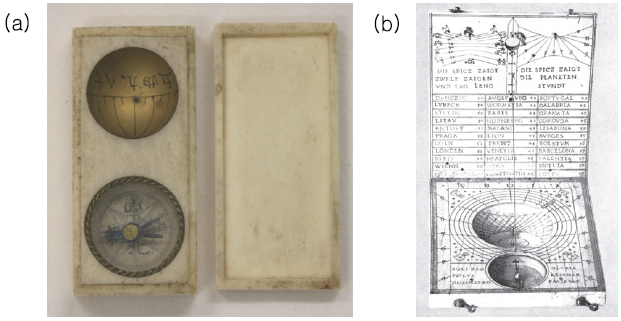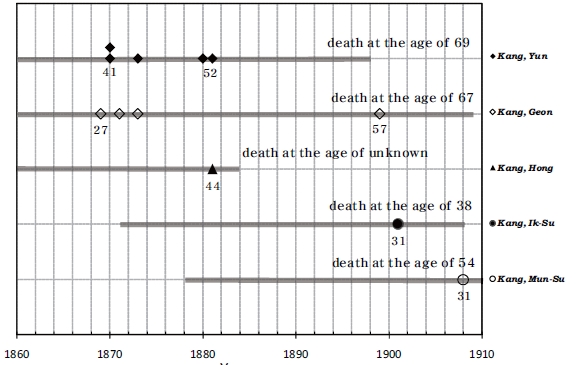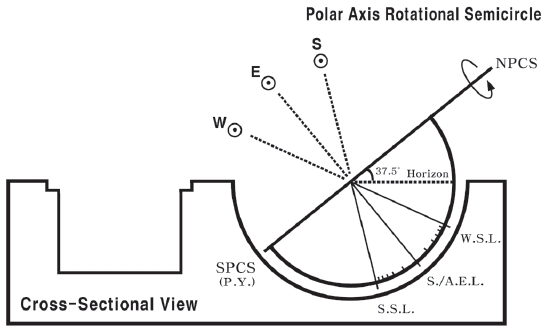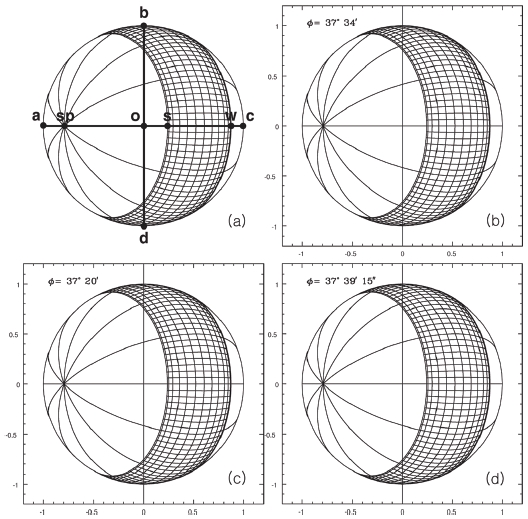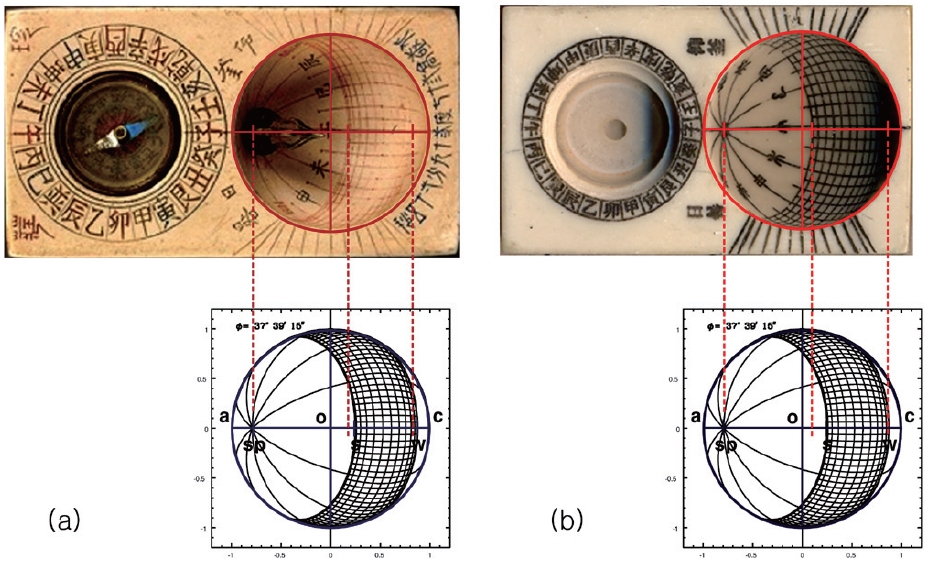It is well known that Yun Kang (1830-1898) and his younger brother, Geon Kang (1843-1909), manufactured several portable sundials. Yun Kang was an official who held the post of Mayor of Seoul. As Kim (2007a) pointed out, however, his father (I-O Kang) and uncle (I-Jung Kang) were also the manufacturers of an armillary clock in the early 19th century. We investigate the relics of the sundials made during the period from the early 19th century to the early 20th century, and find that they are closely related to the Kang Family of Jinju1. In Fig. 1, we present the parts of Yun Kang and Geon Kang from the Sebo (Detailed Genealogy of a Family) of the Family (Compilation Committee of the Sebo of the Jinju Kang Family: Branches of Jukchang-gong2, Seolbong-gong, and Baekgak-gong 1987).
In this paper, we investigate physical characteristics and detailed functions of 12 sundials with an express statement so identify as the person of the Jinju Kang Family. Most are portable-type sundials, while are scaphe or plane type ones. On most sundials, the expression statements of the polar height (i.e., latitude of Seoul), the manufacturer, the lines of 24 seasonal subdivisions (season lines hereinafter) and 12 hours (hour lines hereinafter) and 24 directions were marked. In relation to the hour line, the 96 Gak (Division) method was used, and the line corresponding to 1 Sijin (2 hours in modern time) was subdivided into 8 or 4 intervals.
We also analyze the positions of Yeongchim (a gnomon) and season/hour lines to examine an astronomical manufacturing technique. That is, we compare the projected season lines according to astronomical calculations with those on the sundial relic, using a photograph or a scanning image. This method has the advantage of maintaining the structural beauty while estimating how accurately astronomical principles were applied to the manufacture of the sundial.
In previous research on the sundials of the Joseon dynasty period, Jeon (1963) studied their structure and characteristics, making reference to various literatures and discussing these in terms of history. Later, Lee (1982) performed research on the sundials of the Joseon dynasty, focusing on their history and scientific principles. In the process of studying the astronomical instruments that dated from the reign of King Sejong, Lee (1996), Lee & Nam (1998), and Lee & Kim (2002) also introduced the function of a sundial in the instruments, such as a simplified armillary sphere, a small simplified armillary sphere, a sun-and-stars time-determining instrument, and others. More recently, Kim (2007b) investigated the structure and the usage of sundials that were originally designed at the time of King Sejong but were recently restored.
As mentioned above, thus far all studies on sundials have maintained a focus on history and scientific principles at the base of the literature, or on newly restored sundials of the early Joseon dynasty. In terms of portable sundials, which were a representative sundial type of the later Joseon dynasty, only their introduction and express statement were dealt with briefly in several studies (e.g., Jeon 1974, Jeon 1994a, b, 2000, Korea Foundation for the Science and Culture 1997, National Folk Museum 2004, Needham & Lu 1986, Seoul Museum of History 2004). It was Jeon (1994a) who first studied Yun Kang and Geon Kang, the manufacturers of a portable sundial in the later Joseon dynasty. However, as of yet there has been no study of the Family of Yun Kang and Geon Kang, or an astronomical analysis of their sundials. In this paper, we review the portable sundials made by the Kang Family based on its Sebo, and analyze the sundials in terms of both their accuracy and the manufacturing principle.
1an ancestral seat 2‘-gong’ means a title for a high officer.
In Fig. 2, we summarize the table of descent from the Sebo of the Jinju Kang Family. The Family of Jinju is also called that of Jinsan, because the latter is the old name of the former. As can be seen in the figure, the putative apical ancestor of the Family is I-Sik Kang, who was a general of the Goguryeo kingdom, and the first generation is Min-Cheom Kang, who was a general of the Goryeo dynasty. In particular, Un-Sang Kang of the 13th generation and Baek-Nyeon Kang of the 15th generation both held the post of Yeong-uijeong (Chief State Councillor), hence, the director of Gwansang-gam (the Royal Bureau of Astronomy)3. Hyeon Kang (1650-1733) of the 16th generation is the apical ancestor of the Branch of Baekgak-gong. Se-Hwang Kang (1713-1791) of the 17th generation was a representative literati and painter during the period of the later Joseon dynasty. One of his children, Sin Kang (1767-1821), had five sons. As mentioned above, the first and second sons (i.e., I-Jung and I-O) were the manufacturers of an armillary clock. Their work succeeded the clock of I-Yeong Song, which was a weight-driven armillary clock adopting the principle of a western alarm clock (Kim 2007b).
Of five sons of I-O Kang, Yun Kang (the second) and Geon Kang (the third) are frequently cited in studies of the sundials of the later Joseon dynasty. The courtesy and pen names of Yun Kang (18304-1898) were Deokyeo and Houn, respectively. He held the posts of Gunsu (Prefecture Magistrate) at Seosan in 1864, Hyeongam (County Magistrate) at Haemi in 1873, Byeongmajeoldosa (Army Commander-in-Chief) at Jeolra province in 1887, and mayor of Seoul in 1889. On the other hand, Geon Kang used Eunjung and Haksan as his courtesy and pen names, respectively. He obtained a government position through the Eumsa system5. He held the posts of master of Yeongseonsa6 in 1896, Gunsu at Baekcheon in 1899, and Uigwan (Counselor) of Jungchuwon (the Bureau of State Records) in the next year. Interestingly, he also served as mayor of Seoul in 1900, like his older brother (Yun Kang), great-grandfather (Se-Hwang Kang), and great-great-grandfather (Hyeon Kang). As mentioned above, Geon Kang was famous as a sundial manufacturer, together with Yun Kang. Meanwhile, it is known that his other younger brother, Hong Kang (1838-?), also made a portable sundial in 1881 (Yi 1986).
According to Sebo, Geon Kang had three sons: Ik-Su Kang (1871-1908), Mun-Su Kang (1878-1931) and Bong-Su Kang. However, the first and second sons were adopted by Yun Kang and Ho Kang, respectively. Both sons held the post of Uigwan of Jungchuwon, and made a portable sundial. Ik-Su Kang was awarded a prize in 1902 for repairing a jade investiture document and a gold seal7. As described above, we know that Mun-Su Kang and Ik-Su Kang, the two sons of Geon Kang, carried on the sundial making tradition of the Kang Family. In traditional societies, a technical occupation such as a clock making was the task of Jungin (middle class people). In this regard, it is interesting that high officials made clocks during the later Joseon dynasty.
In Table 1, we summarize the sundials that can be clearly identified as being built by the Kang Family. In Fig. 3, we present their images. Of 12 sundials8, 9 have information on the latitude of Seoul, and these are all written as ‘polar height 37˚ 39′ 15′′’. Because this is the value measured by Ke-Deng Mu and Guk-Ju Ha of China in 1713 (Jeon 2005, King Sejong The Great Memorial Society 1980), we can know that all sundials were manufactured after this year.
Sundials made by the Kang Family can be classified as ‘common’ or ‘portable’ depending on their size, and as ‘plane’ and ‘scaphe’ according to the type of dial plate. Accordingly, inventory nos. 8, 10, 3, and 2 are common plane, common scaphe, portable plane, and portable scaphe sundials, respectively (refer to Table 1 or Fig. 3 for inventory nos.). As can be seen in Fig. 3, a total of 8 are portable scaphe sundials, and are composed of a dial plate with the shape of a dome and a compass with the mark of a direction. While, mostly 24 directions are marked around the compass, inventory no. 7 is marked in 24 directions with twofold. For inventory no. 12, 12 directions are additionally marked inside of the compass, and written as ‘North, East, South, and West’ instead of ‘Ja, Myo, O, and Yu.’
In the hemispherical dial plate, 13 season lines are marked: two for Dongji (Winter Solstice) and Haji (Summer Solstice) and 11 for seasonal divisions from Chunbun (Vernal Equinox) to Cheoseo (End of Heat) other than Haji, or from Chubun (Autumnal Equinox) to Kyungchip (Excited Insects) other than Dongji. That is, seasonal divisions corresponding to symmetric ones, for example Chunbun and Chubun, use the same season line. Regarding hour lines, we find that there are two types: one with the subdivision line of 15-minute intervals, and the other with that of 30-minute intervals. Inventory nos. 2, 5, and 7 belong to the former. Considering that hour lines with the intervals of 15 minutes are generally marked in common sundials made of a bronze, this seems to be an effort to increase the accuracy of the hour markings, although those sundials are of the portable type.
For inventory no. 2, a metal rod (Daryimdae hereinafter) is erected to the side of the dial plate (see Fig. 3). However, its function is unclear, because only a pillar remains. For inventory nos. 7 and 11, Daryimdae was lost. To understand the function of Daryimdae, we investigate a Chinese sundial of the western style that is used in the later Qing dynasty, and a western sundial that remains in Korea (see Fig. 4). As can be seen in Fig. 4a, Daryimdae is a foldable structure, and is connected to the base by a string (yellow color). The orientation of the string becomes the direction of the North Pole in the celestial sphere (NPCS). After the string passes through the upper part of Daryimdae, a cone-shaped pendulum is hung on it. To adjust the horizontal level, screws with a decorated head are installed in three parts. In the sundial of Fig. 4b, the compass, string and pendulum have been lost. Hence, we draw a virtual string (black dotted-line) connecting points a and b, and a pendulum (black-filled circle at the end of the string) facing c point, the pinnacle in the bottom part of Daryimdae. The procedure of placing the pendulum on the pinnacle is very important step before adjusting the orientation of a sundial to NPCS. In a scaphe sundial, however, the string connecting points a and b is useless, because Yeongchim plays its role, pointing toward NPCS. We think that the appearance of Daryimdae in the scaphe sundial of Korea is a fusion with western technology, although it was used only to adjust the horizontal level of a scaphe sundial.
In Fig. 5, we present a scaphe sundial of Japan and a western portable sundial. As can be seen in Fig. 5a, the Japanese scaphe sundial consists only of a main body and the cover made of ivory, but its structure as a whole is similar to that of a Korean scaphe sundial: a hemispherical dial plate and a compass. Regarding the compass part, the north and south directions are clearly written in Chinese characters, and a twisted gold cord is present around the rim, serving a decorative function. At the center of the dial plate, there is a hole for the insertion of Yeongchim. On the other hand, the Korean scaphe sundial is designed so as to put Yeongchim at the point of the south pole in the celestial sphere (SPCS). On the dial plate, hours are written in Chinese characters corresponding the Arabic numerals of 5, 4, 9, 8, and 7 (from right to left in the figure), where 9 corresponds to the noon. The orientation of hour lines is also marked differently from the Korean style. In addition, a single line that appears to be a season line is drawn as a great circle in the horizontal direction. The size of the Japanese sundial is very small, and hour lines are marked at intervals of 1 hour, making the sundial less accurate than those of Yun Kang and Geon Kang, which marked intervals of 15 or 30 minutes. As Jeon (1994b) pointed out, the portable scaphe sundial of Korea is quite unique when compared to those of East Asia, and is also more precise than the imitative one by a Japanese maker. For information on another portable scaphe sundial of Japan, refer to Sawada (1996).
Fig. 5b shows a western scaphe sundial made around the 18th century (Rohr 1996). The shape of the dial plate is hemispherical but less round than a Korean scaphe sundial, and Yeongchim is designed to be located at the center of the dial plate, as in the Japanese sundial. Hence, the overall structure is also different from that of a Korean scaphe sundial. However, a remarkable feature is that the slope of the string towards NPCS can be transformed between 39° and 54°. To utilize this function, concentric circles are marked in the outside of the dial plate, and different hour lines with respect to the latitude are marked in each circle. Another feature is that the sundial is made in a rectangular foldable style, for the sake of portability.
For the sundials made by the Kang Family, we present a diagram showing the production situation in Fig. 6. Of the 12 sundials used in this study, 9 were made by the brothers Yun Kang and Geon Kang. While Yun Kang made 5 sundials between the ages of 41 and 52, Geon Kang made 4 when he was between the ages of 27 to 57 years old. Estimating based on the distribution of the sundial production, presumably Geon Kang would have made sundials when he was between 30 and 50 years of age. Both of the brothers Ik-Su Kang and Mun-Su Kang also made a sundial. We think that there might be more sundials made by the Kang Family that are preserved in Korea or abroad. For this reason, a continuous effort to explore and study the sundials of the Kang Family is required.
The portable sundial manufacturing technology of the later Joseon dynasty originated from the 15th century tradition of making portable equatorial sundials, such as Hyeonju-ilgu (portable horizontal plumb-sundial), Cheonpyeon-ilgu (portable horizontal water-level sundial) and so forth. Meanwhile, portable mechanical timepieces, such as portable pocket watches, had been developed since around the 16th century in western countries (Thompson 2007). This played a role in influencing the practical design of the portable sundial. The advent of a portable scaphe sundial in the Joseon dynasty is believed to be a fusion of western technology via China and the scaphe sundial developed in Joseon.
3During the Joseon dynasty period, Yeong-uijeong concurrently held the directorship of Gwansang-gam. 4According to the Sebo, Yun Kang was born in May of Kyungsin year (1810), Ho Kang (his older brother) in October of Gimi year (1819) and Hong Kang (his younger brother) in Musul year (1838). Considering the relation with his brothers and the history of his official ranks, we think that Yun Kang was actually born in Kyungin. That is, that Kyungsin is a typo of Kyungin. 5In the Joseon dynasty, a man could obtain a government position without undergoing the civil service examination if his father/ancestor was a meritorious subject or a high official.20 6Office that took charge of construction and civil engineering works in the later Joseon dynasty. 7Refer to http://sillok.history.go.kr 8Although it is known that two other sundials, one preserved in a clock company (http://www.timeseoul.com) and the other exhibited to a TV program (KBS Authentic and Master Goods; 7 August 2003), were also made by Yun Kang, we could not include these in this study.
To draw season lines on a scaphe sundial, we have to know the real altitude of the sun in each season using the declination of the sun at that moment and the latitude of a site (Nha 1995). Fig. 7 shows a conceptual diagram of the device drawing a season line on a scaphe sundial: first, produce a polar axis rotational semicircle that can rotate around the axis of NPCS (at this time, the position of SPCS becomes that of Yeongchim), then mark the points corresponding to 13 seasons (Dongji ∼ Chunbun· Chubun ∼ Haji) by rotating the semicircle, and then connect those points. For hour lines, first mark the points over the season line of Chunbun or Chubun with intervals of 15~ on the basis of the longitude line connecting NPCS with SPCS, and then draw each longitude line passing through NPCS, a marked point over the season line, and SPCS.
In general, the investigation of a scaphe sundial is to directly measure the physical size and the intervals of the season and hour lines. Sometimes, a three-dimensional (3D) scanning method is used to accurately measure the intervals drawn on the inside. However, this method is limited in terms of its practical application due to its high price. So if the purpose of the investigation is simply measurement rather than production of a replica, 3D scanning is considered impractical. In this study, we develop a method that can be used to investigate the accuracy of season and hour lines using a 2D image.
There are two methods that can be used to obtain a 2D image: taking a photograph, or using a scanner. In particular, the latter method is very useful for objects with a flat face that can be closely adhered to a plane, such as a scaphe sundial. With a plane sundial, it is possible to scan the face of the sundial after separating or folding Yeongchim. We can examine the season and hour lines of portable sundials by comparing the 2D image with the result of astronomical calculations using a planar projection method.
3.2.1 Planar projection of season lines
Twenty-four seasonal subdivisions are the quantities defined in the ecliptic coordinate system. That is, Chunbun, Cheongmyeong, · · · · · ·, Kyungchip are the times when the sun is passing the ecliptic longitudes (λ) of 0~, 15~,, 30~, · · · · · · 345~, in the ecliptic latitude (β) of 0~. As a result, the planar projection of season lines can be calculated by the following procedures, using λ corresponding each seasonal subdivision.
(i) Declination (δ)
where is the obliquity of the ecliptic and varies according to the period. As the sundials used in this study were manufactured between 1860 and 1908 (see Fig. 6), the maximum and minimum values of are 23.449 (in c. 1885) and 23.460 (in c. 1875) degrees, respectively (Meeus 1998). Nonetheless, we use a constant value of 23.5 degrees based on Yeoksanggoseong (a calendrical book), and find that the difference caused by using slightly different values is negligible, as can be seen in Table 2.
(ii) Azimuth (A) and altitude (h)
where φ is the observer’s latitude, and H is the local hour angle.
(iii) Projection into the x-y plane
where r is the radius of a dial plate.
When projecting the season line of Haji into a plane, for example, we first calculate the declination of the sun at Haji (i.e., λ = 90°) using Eq. (1). Next, we calculate the azimuth and altitude of the sun through the procedure of (ii), using H for the ranges of [0°, 360°] with arbitrary intervals, and compute the coordinate values projected into a plane (i.e., x, y) through the procedure of (iii) for h with positive values. By connecting the coordinates, we can project the season line of Haji into a plane.
3.2.2 Planar projection of hour lines
A sundial is a clock that measures time according to the apparent motion of the sun, and hence its scale marks, or hour lines, indicate the apparent solar time. That is, it is noon when the sun is positioned at the local meridian (i.e., H = 0°) and the length of a day, 24 hours, is the duration until the next noon (i.e., H = 360°). While H varies on a daily basis from 0° to 360° (i.e., 15° per hour), δ annually ranges from - ~ to + ~. As both are quantities defined in the equatorial coordinate system, we can project the hour line into a plane through the procedures of (ii) and (iii). For example, noon is the hour at which H is 0° or 360°, as mentioned above. Using Eqs. (2) and (3), we can calculate azimuth (A) and altitude (h) for the δ of the range of [-~, + ~], with arbitrary intervals. Next, we compute the coordinates projected into a plane, i.e. x, y, as we did in the calculations of the season line. By connecting the coordinates, we can construct the hour line of noon.
3.2.3 Planar projection according to the site
In Fig. 8, we present season (b-d direction) and hour (a-c direction) lines projected into a plane with respect to the observer’s latitude. In the panel of the legend, the length of a-c or b-d represents the diameter of a scaphe sundial, while o represents the location of the tip of Yeongchim. sp, s and w represent SPCS, Haji and Dongji points, respectively. The other panels show the projected season and hour lines for various φ: (b) for 37˚ 34′, modern value of the latitude of Seoul (Korea Astronomy and Space Science Institute 2009), (c) for 37˚ 20′, value written in the treasure of no. 845-19, and (d) for 37˚ 39′ 15′′, value presented in the express statement of the sundials of Kang Family.
When we assume the length of a - c as unity, then that of a - o is 0.5. The lengths of a - s and a - w are the distances to the Haji and Dongji points, respectively10. In terms of the hour line, we draw it with the intervals of 15 min (i.e., 15, 30, and 45 minutes). In Table 3, we present the distances to the points of SPCS, NPCS, s and w for four sites: 36˚, 37˚ 20′, 37˚ 34′, 37˚ 39′ 15′′, and 38˚10.
According to astronomical calculations, the lengths of a-sp, a-s and a-w are 10.4 mm, 62.2 mm and 93.8 mm, respectively, when φ is 37˚ 34′ and the diameter of the dial plate is 100 mm. On the other hand, these are 31.2 mm, 186.6 mm and 281.4 mm when the latitude is the same but the diameter is 300 mm. In Table 4, we present the lengths of a-sp, a-s and a-w with respect to the observer’s latitude, assuming the diameter of 30 mm (i.e. traditional size of a portable scaphe sundial). As can be seen in the table, the differences caused by using a different latitude are very small. In this case, it is hard to discern the effect of the observer’s latitude using season lines. On the other hand, it is possible to distinguish the effect on a bronze scaphe sundial typically with a diameter larger than 300 mm, particularly at the positions of SPCS, s and w.
To examine the positions of season lines on a portable scaphe sundial, we test for two images: (a) for a real sundial made by Mun-Su Kang in 190811 and (b) for a commercial one manufactured by a company in 2002. In the calculations of planar projection, we use φ of 37˚ 39′ 15′′. Through the examination, we found that caution is required when selecting/taking a photograph or scanning.
Fig. 9a shows the result for the sundial of Mun-Su Kang. We adjusted the image scale for direct comparison, and found that while the position of sp shows good agreement, the positions of s and w are somewhat shifted toward sp. This disagreement might be caused by the misalignment of the optical tilt and the optical shift. Actually, the position of Yeongchim is not centered in the photograph. For this reason, we think that careful attention must be paid when selecting or taking the photograph of a sundial. Fig. 9b shows the result for the commercial sundial. We obtained the image of the sundial using a scanner, and compared it with the result by the calculation of planar projection. As result, we found that while the positions of sp and w show good agreement, the position of s shows displacement toward sp. As we obtained the image of the sundial maintaining a horizontal level, we think that this disagreement is caused by a manufacturing error in the commercial sundial itself.
We should keep one thing in mind in comparing the projected season lines of a real sundial with those obtained by calculations. Although there are some distortions in the surface of a dial plate, it does not cause a serious problem to read a season line in a real scaphe sundial if the line was constructed so as to agree with the incident angle of the ray of the sun. When the distortion in the surface is projected into a plane, however, it may cause an error. For this reason, we need to check the degree of the roundness of the surface of the dial plate when using a projected image.
In Fig. 10, we present a digital image of a real scaphe sundial made by Yun Kang in 1880. As can be seen in the figure, the position of sp is clearly evident because of the loss of Yeongchim. Although there was no notable distortion in the dial plate, its diameter shows asymmetry (i.e., 47.6 mm in the horizontal direction and 46.4 mm in the vertical direction). It was hard to obtain the digital image using a scanner due to the remains of Daryimdae, so we used a digital camera (Canon 5D, Canon Lens Macro 100 mm/f2.8).
As in Fig. 9, we compared the season lines of the sundial of Yun Kang with those obtained by calculations using φ of 37˚ 39′ 15′′. As a result, the positions of sp, s and w show relatively good agreement. We also compare the season and hour lines by overlapping two images (see the upper-right picture in Fig. 10), and find that both images are considerably in accord with each other. It seems that the sundial is adequate for use for practical time measurement if the lost Yeongchim is restored.
In the comparison of projected season lines with respect to the observer’s latitude (36˚~38˚), the difference within the angle of less than 1˚ can be easily distinguished by the position of s rather than by that of sp or w. Nonetheless, it is practically impossible to verify the polar height (i.e., observer’s latitude) used in manufacturing a sundial within an arcminute range. Instead, this 2D projection method will be useful as a simple check, particularly in terms of astronomy, for scaphe sundials that are preserved in a general or science museum. For a more detailed inspection, we believe that 3D measurement is required.
9Treasure no. 845 is divided into 845-1 and 845-2. The former is 35.2 cm in diameter and 14 cm in height, and was manufactured in the later 17th century, while the latter is 24.3 cm in diameter and manufactured around the early 18th century. Both are currently preserved in National Palace Museum of Korea. 10In Fig. 8b-d, we assume the radius as unity. In Table 3, on the other hand, we present values in the ratio of the diameter of unity, for the convenience of conversion. 11Image source: Seoul Museum of History (http://www.museum.seoul.kr)
In this paper, we investigate Sebo of the Kang Family of Jinju, which was closely involved in the manufacture of sundials during the later Joseon dynasty period. Of the 12 sundials made by the Family, 8 are portable scaphe types, which is a unique style that was first developed in the Joseon dynasty, and that was influenced by the western portable plane sundial. In particular, the advent of Daryimdae in Korea’s scape sundials can be understood as a fusion with western technology. Although similar sundials can be found in Japan, they are inferior to Korean sundials in terms of the manufacturing technique and the level of accuracy.
To verify the accuracy of the sundials made by Yun Kang and Geon Kang from an astronomical point of view, we used 2D images of the sundials that were obtained using a photograph and a scanner. In the process of this study, we found that it is important to use the devices of optical tilt and shift in taking a photograph, in order to avoid the distortion of the image. Throughout the analysis for the construction of season lines, we also found that differences of less than 1˚ in the polar height were minor in terms of estimating the accuracy of a portable scaphe sundial. In other words, a portable scaphe sundial can also be used in Gyeonggi-do, a province surrounding Seoul. From this point of view, it can be evaluated that a portable scaphe sundial is a time measurement device that emphasizes practicality and convenience rather than accuracy.
In conclusion, we think that the 2D projection method is very useful for estimating the actual area of a sundial in use, and the latitude applied to its manufacture. We also think that this study is helpful for restoring the damaged season or hour lines, determining the length of the lost Yeongchim, and reconstructing sundial relics.




